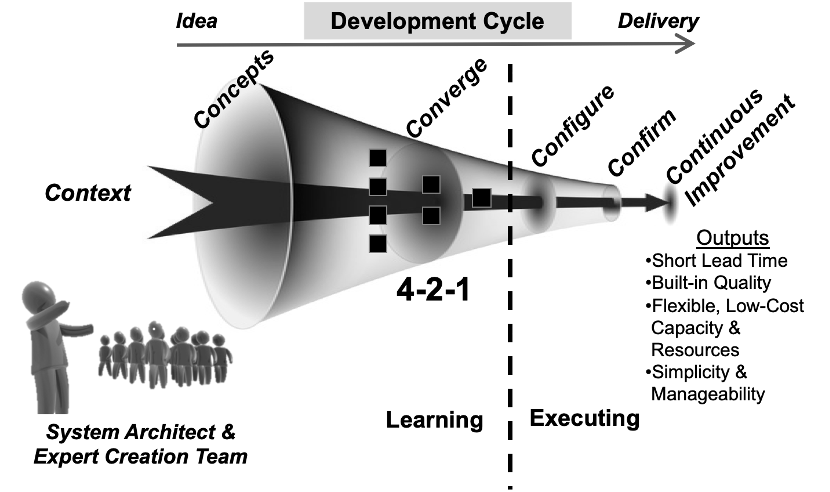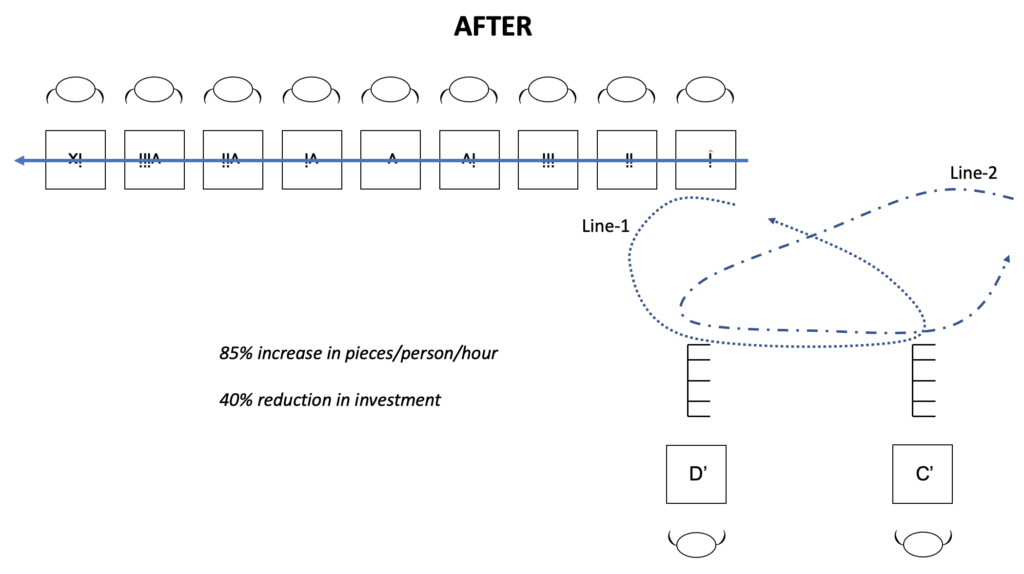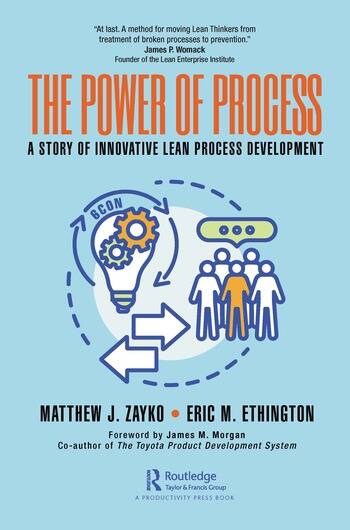The Competitive Advantage of Lean Process Creation
Feb 25, 2022

SERIES – The authors of The Power of Process open their new series by explaining why it’s critical to integrate product and process development.
Words: Eric Ethington and Matt Zayko
“All the ills of the organization show up on the production floor.”
John Shook
MARY SHELLEY STRIKES!
As the new manager at the site, I was trying to be respectful about what I was seeing. I had learned long before that there was always a reason why things were the way they were. Perhaps not a great reason, but a reason that made sense at the time. Then I walked into the environmentally controlled pump production room. It had been recently installed and was touted as the latest in Lean Thinking. In reality, it was a “Frankenstein” process – a bunch of lean concepts stitched together.
It was single-piece flow, until you reached the rotating buffers of six pieces between each station. Yes, rotating in circles on turntables. It had no chairs, yet there was no machine time to allow the operators to move to another operation. They had to stand there all day as if they were standing guard outside of Buckingham Palace. The cell was U-shaped, yet it was hard to take advantage of this configuration – its only impact was to make material delivery a challenge. And so began the work of collecting motion data, machine data and other process information to reconfigure this well-intentioned attempt and turn it into something better.

LENSES TO SEE BETTER
Our recent book, The Power of Process, introduced the specific frames (6CON) for people to look through to properly design a new process while optimizing the value-creating resources. The framing is applicable to the creation of any process that involves people, technology, or equipment, whether the application is in manufacturing, healthcare, services, retail, or any other industry. This framework can result is 30-50% improvement in safety, first-time quality, customer lead-time, capital efficiency, labor productivity, floorspace, and more that could add up to millions of dollars per year and a 10x payback.
In the coming months, we will release a series of articles focused on the six frames that make up the 6CON model—Context, Concepts, Converge, Configure, Confirm, and Continuous Improvement. This initial article helps us to make the business case for the all-important integration of product and process development.

6CON Model for Lean Process Creation (The Power of Process, Zayko & Ethington, 2021)
When writing the book, we discussed how to best tell the story in order to effectively share the social and technical system interaction that’s necessary to achieve truly great process creation. We settled on an industrial product (high voltage switch) that is built in a manufacturing environment, and we based the story on a real-life example. One reason we chose the high voltage switch is that it is a physical, tangible product that is easier for the reader to envision, even if they are not from a product-based or manufacturing-based organization. Your “product” may be a clinical patient pathway, a retail customer experience, or other activity.
MANUFACTURING MATTERS
But a more important reason we chose this example is that manufacturing is still an enormous driver of economic power, despite its diminished role in many developed countries the past few decades. In the United States, the manufacturing industry alone would represent the 8th largest economy in the world. The Research & Development (R&D) spend in the US on manufacturing and processes is nearly $300 billion annually, with another $200 billion spent on new capital equipment for manufacturing and nearly $60 billion on facilities for all the equipment. Over 12 million people are employed in the US manufacturing industry, including nearly 1 million engineers – 25% of the total engineers in the country. Most companies around the world spend in the range of 3%-15% of their annual revenue on R&D investment. Additionally, the Covid-19 pandemic and other world events have reminded us of how fragile our extended supply chains are – a realization that could herald a large wave of investment.
Despite all the growing investment in people and capital resources for manufacturing processes around the world, however, most organizations do not have a standard approach for creating new processes. This results in both an overspend on capital and excessive manual work in the range of 30-50% (based on our 25+ years of experience, we estimate that less than 10% of organizations have a standard approach for lean process design that is integrated in with new product development).
IT’S IN THE DETAILS
When we dig deeper we find a basic lack of understanding by those designing the new process. Sometimes the cycle times and their relationship to a takt time have been calculated, but most often they have not. When we start questioning projected yields, changeover times, lot sizing, motion paths, and balance options, the information becomes even murkier. Essentially, the organization and its managers are about to spend significant money on capital but have only a vague understanding of why. Again, this is normal and will continue to be normal because no one ever asks at the end, “did we get our money’s worth, or did we achieve our objective?” An overarching financial number may be scrutinized, or perhaps launch timing, but how often are the real root causes of any variances identified and shared for learning? Generally never.
Given this limited upfront process development activity, there is a critical need to change the approach to create new value streams and processes, and a great way to realize this need is through the power of storytelling. There are a lot of well-meaning, smart people who, year after year, create processes that are laden with issues as soon as they launch. 6CON is a developed practice, not a set of tools, to move an organization’s process development from individual decisions to a holistic approach. And since 70% or more of the cost of a product or service is typically locked-in once the designs are selected, it is a huge competitive advantage for the few companies that have figured this out.

The Cost Forest: Development’s Actual Influence on Cost (The Power of Process, Zayko & Ethington, 2021)
The Power of Process is written to connect a realistic transformation with the detailed technical challenges as well as the engagement of the stakeholders, each with their own biases. Key points and must-do actions are offered throughout the book to reinforce learning from the specific to the general. In the case study, an empowered working team is charged with developing a single production line for a new product. As the story unfolds, they create an improved process that saves $5.6 million (9x payback) over the short life cycle of the product, as well as other measurable benefits in quality, ergonomics, and delivery. To an even greater benefit, they establish a new way of working and engaging people that can be applied to all future process creation activities in order to minimize post-launch “touzen” – the rework that happens with poorly designed processes, that frequently tries to masquerade as kaizen.
To do this upfront development work properly and create a solid lean process, one has to face up to the complexity of collaboration required and to the continuous improvement skepticism that people will bring to a project, because of their past bad experiences. It is our goal to share the thinking within each of the 6CON frames and behind the concepts to demonstrate the logic by which one might derive their own situational approach, an engaging approach that will enhance value while avoiding waste in the first place.
OUR WAKE-UP CALL
To go back to the story that opened this article, please realize that this is not a great example of lean process creation, but one of kaizen that should not have been necessary had the right process been designed to begin with. With attention to the details of the process, the cell was actually reconfigured from six primary stations to nine stations balanced within a second or two of one another. This meant that we added three people to the operation, but productivity, measured in pieces per person per hour, increased by 85%. Two feeding processes that were directly connected to the back of the original cell were decoupled and a small supermarket was established. We added inventory, but with some simplification of the subassembly stations the team were now able to feed two assembly cells instead of one. The increased productivity allowed us to forego the purchase of yet another cell, reducing investment by 40%.

To quote Deming, “A bad system will beat a good person every time.” Great people designed the first iteration of this process and great people learned and redesigned the improved process, but had we not reflected and asked how we could avoid this situation in the future we would have continued being stuck in the rework game. We had our “wake-up call”. The next decision was ours.

For more details, please visit www.thepowerofprocess.solutions
THE AUTHORS

Matt Zayko is Lean Leader at GE Hitachi Nuclear Energy.

Eric Ethington is a Senior Lean Coach and Program Manager, Lean Product and Process Development, at the Lean Enterprise Institute.
Original Article: https://planet-lean.com/lean-process-competitive-advantage/
Stay In Touch.
Subscribe to our newsletter and exclusive Leadership content.
